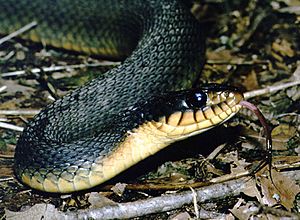Plain-bellied water snake facts for kids
Quick facts for kids Nerodia erythrogaster |
|
|---|---|
 |
|
| plain-bellied water snake Nerodia erythrogaster |
|
| Conservation status | |
| Scientific classification | |
| Genus: |
Nerodia
|
| Species: |
erythrogaster
|
| Synonyms | |
|
|
The Nerodia erythrogaster, also known as the plain-bellied water snake, is a common snake found in the United States. These snakes are mostly aquatic, meaning they live in or near water. They are non-venomous, so they are not harmful to humans. This type of snake is a colubrid, which is a large family of snakes. It is also endemic to the U.S., meaning it is only found there naturally.
Contents
What Does the Plain-Bellied Water Snake Look Like?
The plain-bellied water snake is a large snake with a thick body. Its color can vary, but it is usually a solid shade of brown, gray, olive green, greenish-gray, or black. Some lighter-colored snakes might have dark blotches on their backs.
You can tell this snake apart from other water snakes by its belly. It has a plain, unmarked underside that can be red or yellow. This is why it's called the "plain-bellied" water snake – its belly has no patterns! Adult snakes usually grow to be about 24 to 40 inches (76 to 122 cm) long. Young snakes have patterns that look like other banded water snakes, but their plain bellies help you identify them.
Where Do Plain-Bellied Water Snakes Live?
Plain-bellied water snakes live in the southeastern United States. You can find them from Florida up to southeastern Virginia. They also live near the borders of eastern North Carolina and western Tennessee.
These snakes almost always live close to water. They prefer places like rivers, floodplains, lakes, ponds, and wetlands. Wetlands are areas where the land is covered by water, like swamps or marshes.
How Do Plain-Bellied Water Snakes Behave and What Do They Eat?
Plain-bellied water snakes are most active during the warmer parts of the year. In the hottest summer months, they can be active both during the day and at night. You might see them resting in the sun on logs or near water. They also swim in the water or travel over land.
Sometimes, when the weather is hot and humid, they will travel far away from water. It's a bit unusual for a water snake to spend so much time on land. During the coldest winter months, they hibernate, which means they go into a deep sleep to save energy.
These snakes get most of their food from the water. They mainly eat fish, crayfish, salamanders, and frogs. Because they spend time on land, their diet also includes many amphibians. Like most snakes, they hunt for their food. However, they have also been seen waiting quietly in the water for prey to come close. They catch and swallow their prey alive without squeezing it.
Life Cycle and Reproduction
This snake gives birth to live young. This is similar to other North American water snakes and garter snakes. They do not lay eggs. Breeding happens from April to mid-June in the southeastern U.S.
Female snakes usually give birth in August or September. They can have many babies at once. A typical group of babies is around eighteen. One female snake in North Carolina was even seen with 55 baby snakes! In 2014, a female snake in captivity had two healthy babies without a male snake. This is called parthenogenesis, which means "virgin birth."
Who Are Their Predators and How Do They Defend Themselves?
Plain-bellied water snakes can be hunted by animals that live on land and in water. Some animals that eat them include largemouth bass fish, kingsnakes, cottonmouths, and several types of egrets and hawks.
When these snakes feel threatened, they usually try to escape. They might also bite or release a bad smell to scare away predators. Unlike some other water snakes, the plain-bellied water snake will leave the water and try to escape over land if it feels in danger.
Conservation Status
The plain-bellied water snake faces some risks. One problem is that they often travel over roads and highways, which can be dangerous. Also, when wetlands are destroyed or damaged, it harms the snake's home.
This snake is not a protected species in most southeastern states. However, one type of plain-bellied water snake, the copper-bellied water snake, was listed as a threatened species in Ohio, Michigan, and northern Indiana in 1997. This means it has special protection under the Federal Endangered Species Act in those areas.


